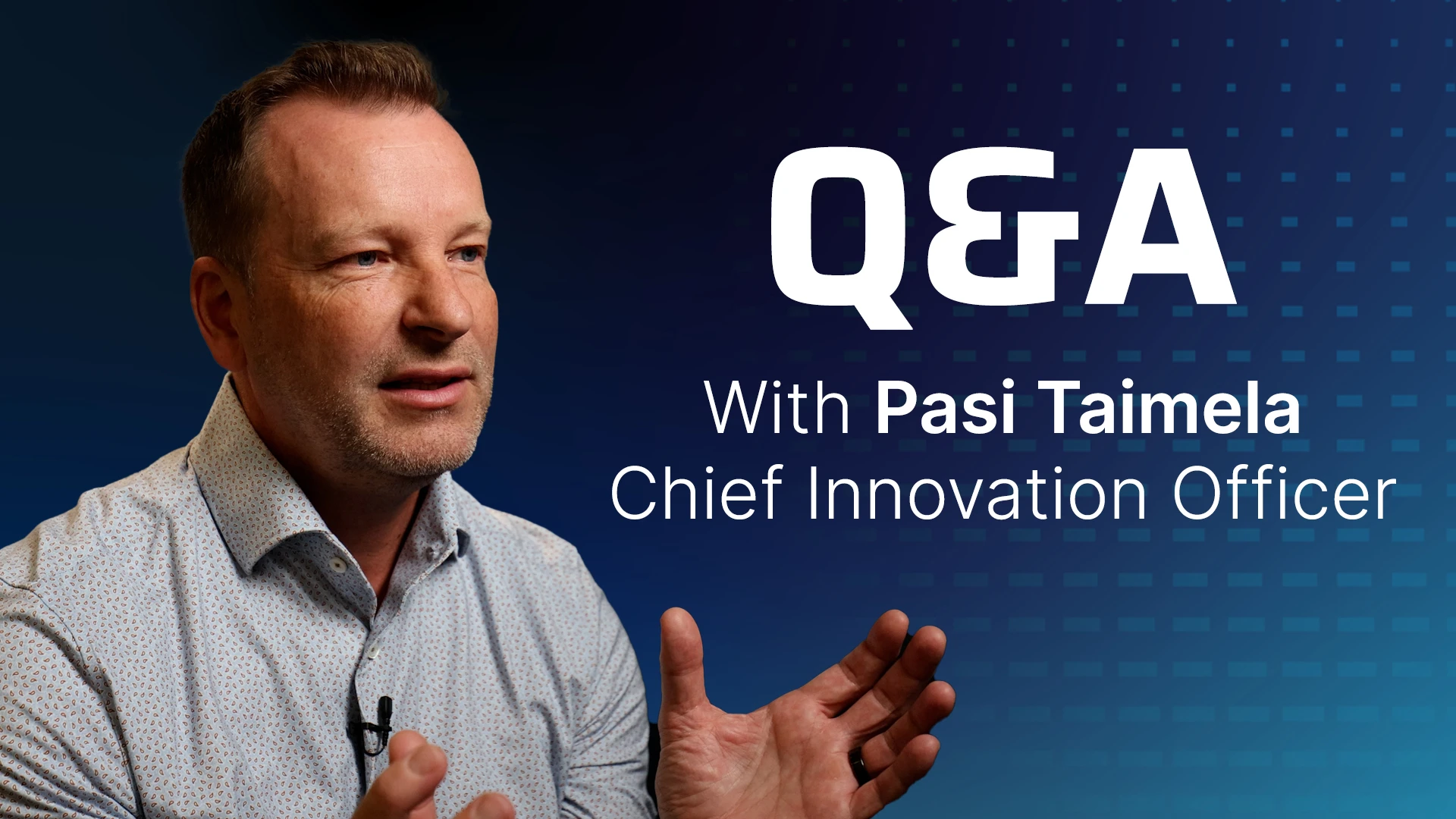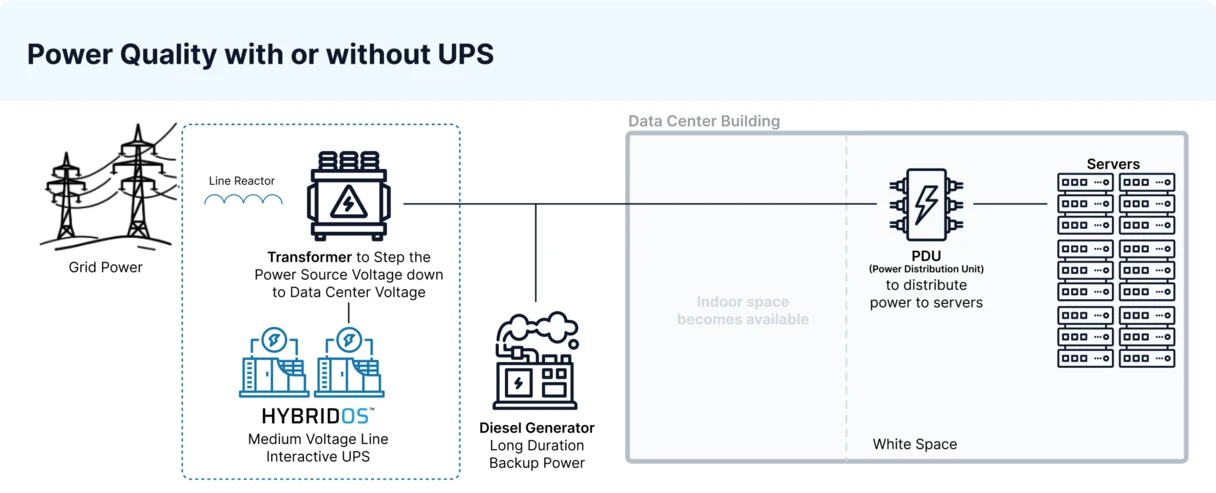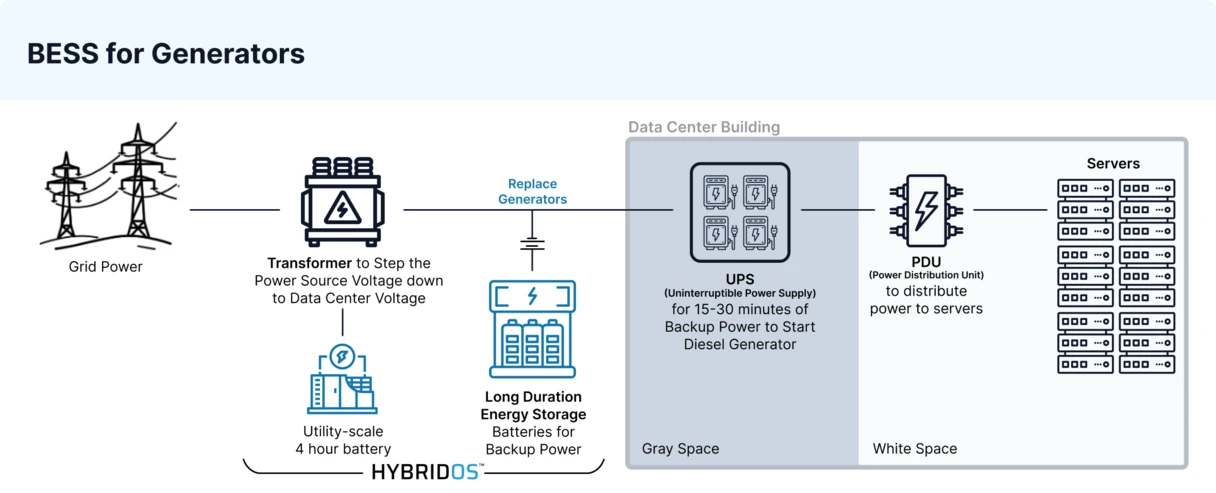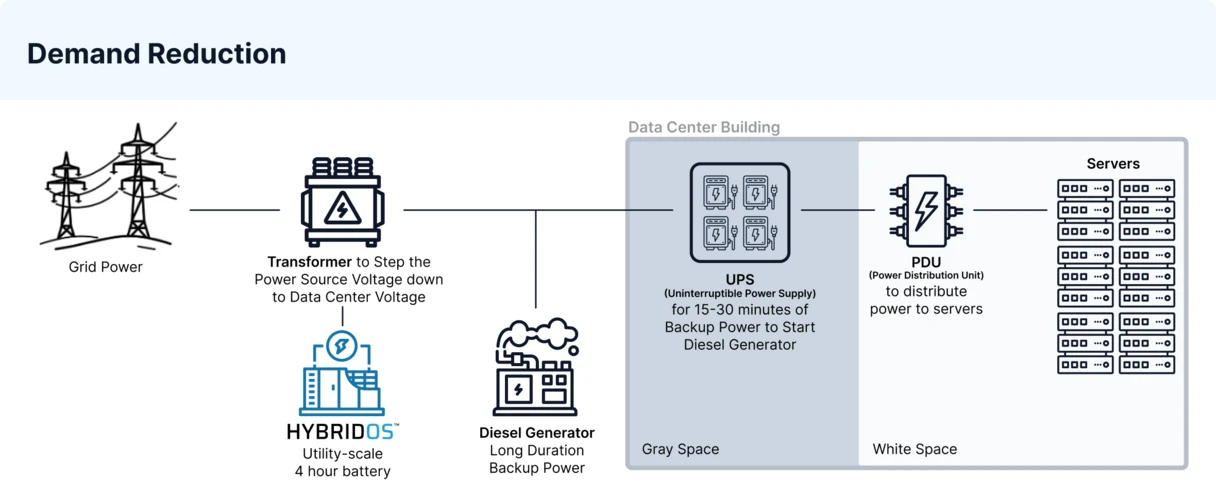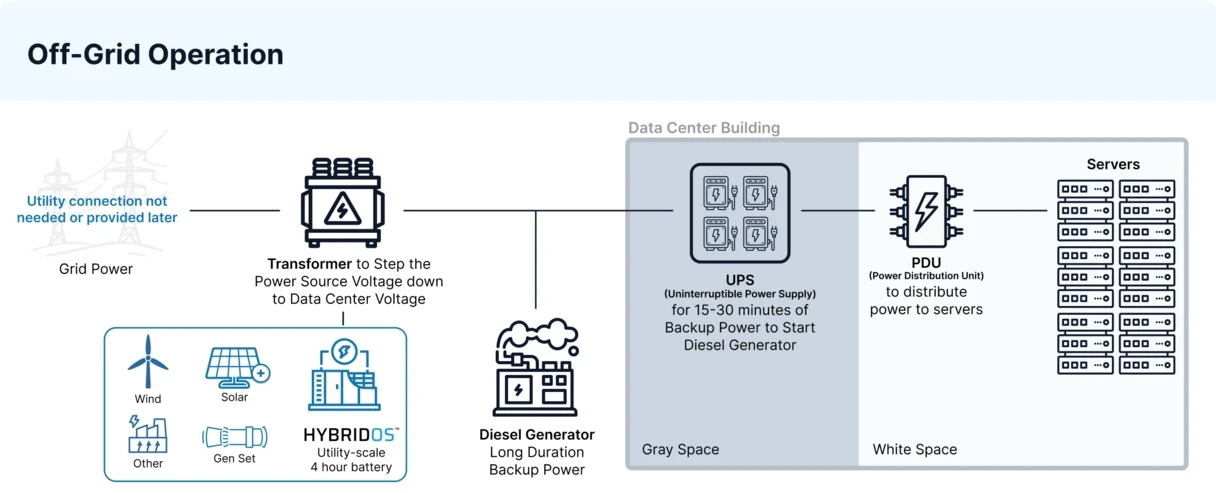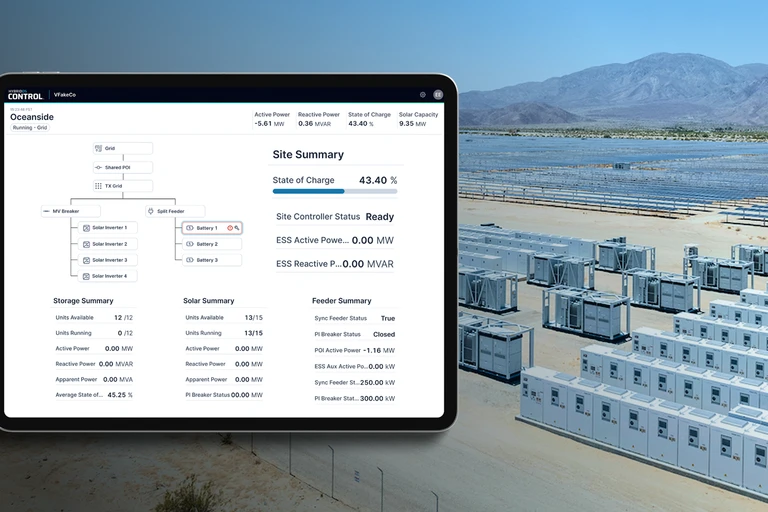Data centers require the utmost power stability to operate effectively and reliably—even a 20-millisecond power disruption can impact data processing. Voltage, frequency, and waveform deviation have serious consequences for equipment uptime, performance, and lifespan. In fact, power disruptions are the leading cause of data center outages, and 70% of all data center outages cost businesses $100,000 or more.
When it comes to data centers that support AI training and workloads, maintaining high power quality becomes an even bigger challenge. While today’s average server rack requires a steady 15 kW of electricity, advanced AI computing will require 120 kW or more per rack, drastically increasing data center power density. On top of those density requirements, the power profiles of these data centers can be volatile, rapidly fluctuating in sub-seconds as AI models are trained.
AI data centers need innovative power solutions fast, and fortunately, battery energy storage systems (BESS) are flexible, quick to implement, and can replace a traditional uninterruptible power supply (UPS). To go deeper on this topic, we sat down with Pasi Taimela, FlexGen’s Chief Innovation Officer, who has been integral in developing BESS solutions for data centers that enhance power quality, enable seamless operational transitions, mitigate power surges, and reduce capital expenditures.
How are advanced AI workloads impacting data center power needs?
Pasi Taimela, CIO: Large language model AI training and processing is driving two big changes in data center power, which shifts how we should approach their power quality solutions, UPS systems, and power backup moving forward.
The first change is scaling up the necessary power. To put that into context: when I worked in the data center industry 17 years ago, our largest rack-level power unit was six kilowatts. Today, Nvidia has released the latest generation of AI servers, and we’re looking at needing 120 kW or even 300 kW on a single rack. The power density of data centers is increasing exponentially.
The second change is that an AI load profile is cyclical because of large language model training. It is a neural network where the training computing is highly synchronized, which means that all the servers are processing at the same time. As the large language model training sequences through, tens to hundreds of megawatts of power are being used at a time, creating a very cyclical load profile. In contrast, a data center used for cloud computing, web processing, or even some communication processing would be a very steady electric load. That’s no longer the case with advanced AI.
Why are conventional UPS solutions no longer enough?
Pasi: Data centers use UPS systems to ensure continuous uptime using high-quality power, even if the grid experiences a disruption. Typical data centers have nine different power quality problems, including voltage sags, over-voltage, harmonics, frequency variation, and grid outage faults. A traditional UPS solution protects data center equipment from these problems with two primary components: a UPS system and a backup diesel generator.
Inside a data center, a rack-level UPS would allow for a few minutes of runtime in the case of a power quality issue, and a central UPS—typically in 1 MW building blocks—can provide 5-12 minutes of runtime. If a power issue or outage lasts longer than the UPS system can cover, a diesel generator will provide longer-duration backup.
In the case of power-dense and cyclical AI workloads, this UPS configuration will no longer be feasible, as it can’t meet the scale and power density needed in AI data centers. Moving forward, we need solutions like BESS that can scale to tens or hundreds of megawatt power levels, offer extended 4- to 8-hour backup, and still maintain optimum power quality.
How can BESS support power quality for data centers?
Pasi: Software-controlled BESS—think utility-scale 4-hour batteries—are an established energy technology that now have the potential to innovate data center operations. BESS deliver millisecond-fast cutovers in reaction to power disturbances and can serve as real-time shock absorbers to stabilize power supply. When installed at data centers sites, BESS help ensure a stable power supply by smoothing voltage fluctuations, reducing harmonics, and providing instant backup power.
This is especially important as our electric grid evolves. When there is a higher penetration of solar and wind energy on the grid, issues with power quality naturally increase due to resource intermittency and variability, reduced inertia, and other inherent qualities of renewable generation technologies. Large-scale battery systems can help maintain inertia to prevent grid issues from escalating and stop grid power quality problems before the electricity ever enters the data center.
How is FlexGen approaching the AI power challenge and supporting data center customers?
Pasi: There is a need in the space for companies that understand both sides of the data center power challenge: data center operations and energy systems. At FlexGen, we’ve spent over 15 years pursuing power quality energy solutions for military, oil and gas, and marine applications, which gives us deep, relevant experience for addressing data center power quality needs. We’ve also spent 7 years working in the renewable energy space, so we’re in a very good position to fill the gap of integrating renewables and other generation sources with data centers, supported by BESS.
We’ve established partnerships with companies who bring a similar, well-rounded perspective, with expertise on both sides. For example, we’ve partnered with Rosendin, one of the largest electrical contracting companies in the U.S., to bring to market a first-of-its-kind, utility-scale battery solution that can act as a reliable, high-performance alternative to conventional UPS systems outside of the data center building.
What BESS configurations allow for data center power quality improvements?
Pasi: Utility-scale batteries enable data centers to deploy a range of energy strategies. At FlexGen, we have identified four use cases for how to best integrate large-scale batteries into data center systems. These configurations can be used individually, or multiple can be combined into a single system design.
1. Line-interactive UPS configuration: BESS can function as a medium-voltage, line-interactive UPS system for data centers, delivering 24/7 power with UPS-levels of power quality—99.9% to 99.999% uptime.
Diagram illustrating how BESS can function as a medium-voltage, line-interactive UPS system.
2. Generator replacement configuration: Instead of diesel backup generators, data centers can adopt utility-scale battery systems for long-duration, 4- to 8-hour backup power, which is not only cost efficient but also delivers high power quality.
Diagram illustrating BESS serving as backup power for data centers, replacing generators.
3. Demand Reduction: Deploying a utility-scale 4-hour battery system behind the meter at a data center can expedite grid interconnection and help ensure that data center operations aren’t impacted by disruptions or cascading grid failures.
Diagram illustrating utility-scale batteries deployed behind the meter to give data centers unprecedented control over their energy strategy.
4. Off-grid operations: In this microgrid configuration, a utility-scale 4-hour battery system is integrated with generation assets or co-located with power plants to ensure power quality and enable complete grid independence for a data center.
Diagram illustrating BESS integrated with a variety of generation assets to enable grid independence.
Tell us more about how BESS can serve as an alternative to a conventional UPS?
Pasi: As I mentioned, in the case of a power outage, most data centers rely on a UPS system for near-instantaneous backup power until a standby power source—typically a diesel generator—kicks on after a few minutes.
With BESS, we can combine both functions into a single, streamlined solution. BESS can instantly take over during a power interruption like a UPS does, while also offering extended backup power for 4 to 8 hours, replacing the need for a diesel generator.
In other words, a battery system can be configured to function as both a medium-voltage line-interactive UPS and a backup generator replacement—all in one unit. This approach significantly reduces the number of components required, which in turn lowers capital expenditures for data centers.
What’s more, a large-scale BESS is far more scalable than traditional UPS systems. We can install BESS outdoors as a medium-voltage system—operating at around 34,000 volts—and increase the power level from 10 MW up to 100 MW building blocks. This is crucial for today’s AI data centers, which will demand up to 10 times more power.
Such scalability and power density simply aren't feasible with traditional UPS solutions.
Beyond the unique configuration of a battery system, how does FlexGen ensure power quality for data centers?
Pasi: Powerful software is critical to BESS data center solutions because it acts as the brain of energy assets and is essential for optimizing uptime. FlexGen provides comprehensive and proven solutions to integrate systems fast, ensure optimal BESS performance, and provide insights for effective asset management.
HybridOS, our best-in-class energy management system (EMS) software, maximizes BESS performance and can coordinate multiple BESS units within a data center campus or even a fleet of sites with instantaneous monitoring, web-based controls, and automated APIs. Additionally, HybridOS Analyze, a powerful tool for predictive data insights, monitors asset health and supports preventative maintenance to enhance the performance and extend the lifetime value of a data center’s energy storage assets.
Tackle Data Center Power Challenges with BESS
With over 15 years of energy storage experience, FlexGen offers turnkey and hardware-agnostic solutions for designing, integrating, and operating BESS, with specific configurations for data center use cases. From millisecond-fast cutovers to replacing legacy UPS systems, utility-scale, software-controlled batteries offer an effective power quality solution for modern AI data centers that require large volumes of highly stable power to optimize operations.
